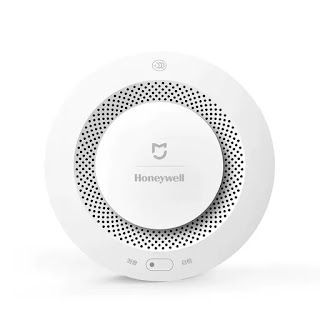Mi Smart Smoke Detector (Honeywell)
Product model: jtyj-gd-01lm/bw
Working temperature: -10 ℃ ~ + 55 ℃
Fire alarm response time: <20 seconds
Battery fault alarm response time: <60 seconds
Average power consumption in normal monitoring state: <14uA
fault alarm duration: ≥7 days, can continue to report fire for 4 min after one day
Fire alarm sound pressure: ≥80dB @ 3m
Sound method: progressive sound alarm, the initial sound pressure does not exceed 45dB @ 3m, and finally reach the fire sound pressure standard
Power supply mode: 3VDC (not so common) CR123A lithium battery
Battery capacity: 1450mAh
The Mi Smart Smoke Detector is made in cooperation with Honeywell. The logos are prominently visible on the product. I guess they wanted a reliable and well know brand on their product to gain trust from potential buyers. To be honest, this is what persuaded me to go for this product because I don't want to rely on something badly made to guard my house from burning down.
The product comes with a mounting plate, double sided tape and screws, a battery and some manuals. Mounting the detector is a matter of seconds with the tape, and (for me) just two minutes with the screws. You cannot connect the detector to its plate when no battery is installed, which is standard and maybe even required.
The smoke detector has just one button which has multiple functions: device setup, self-test and mute.
The detector works as a standalone unit, this means when your wifi is down it will still function. It produces a lot of noise, enough to hear trough the whole house. It can send an alert to the gateway (linkage hub alarm) and you can set all kinds of automations with it of course.
The alert sound is progressive, this means that it starts loud and keeps getting louder. The specifications state that it starts at 45 decibel and will progress to 80 decibel. This is a nice feature when you have a false alarm and can disable it with the button on the unit without having to endure 80 dB of beeping.
Specifications:
Operating humidity: 0 ~ 95% RH, non-condensingWorking temperature: -10 ℃ ~ + 55 ℃
Fire alarm response time: <20 seconds
Battery fault alarm response time: <60 seconds
Average power consumption in normal monitoring state: <14uA
fault alarm duration: ≥7 days, can continue to report fire for 4 min after one day
Fire alarm sound pressure: ≥80dB @ 3m
Sound method: progressive sound alarm, the initial sound pressure does not exceed 45dB @ 3m, and finally reach the fire sound pressure standard
Power supply mode: 3VDC (not so common) CR123A lithium battery
Battery capacity: 1450mAh
The Mi Smart Smoke Detector is made in cooperation with Honeywell. The logos are prominently visible on the product. I guess they wanted a reliable and well know brand on their product to gain trust from potential buyers. To be honest, this is what persuaded me to go for this product because I don't want to rely on something badly made to guard my house from burning down.
The product comes with a mounting plate, double sided tape and screws, a battery and some manuals. Mounting the detector is a matter of seconds with the tape, and (for me) just two minutes with the screws. You cannot connect the detector to its plate when no battery is installed, which is standard and maybe even required.
The smoke detector has just one button which has multiple functions: device setup, self-test and mute.
The detector works as a standalone unit, this means when your wifi is down it will still function. It produces a lot of noise, enough to hear trough the whole house. It can send an alert to the gateway (linkage hub alarm) and you can set all kinds of automations with it of course.
The alert sound is progressive, this means that it starts loud and keeps getting louder. The specifications state that it starts at 45 decibel and will progress to 80 decibel. This is a nice feature when you have a false alarm and can disable it with the button on the unit without having to endure 80 dB of beeping.
Device sensitivity
The great thing about this smoke detector is that it has three sensitivity settings. I had some trouble with a smoke detector placed in the kitchen which could be set off when I opened the oven or when the cooking oil let off some smoke. You do need the Mi Control Hub to change the settings.Conclusion
I think it is a cost effective addition to my home. Depending on where you live you may be required to have a certified smoke alarm which this unit lacks (except for China), but from what I am aware of it is not against the law to have an additional smoke detector which can make your detection smart. It is a lot cheaper than the other (maybe certified options) like the Nest Protect which had their own problems.





Comments
Post a Comment